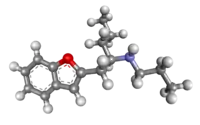 | |
 | |
| Clinical data | |
|---|---|
| Other names | (-)-1-(Benzofuran-2-yl)-2-propylaminopentane; |
| Identifiers | |
| |
| CAS Number | |
| PubChem CID | |
| ChemSpider | |
| UNII | |
| Chemical and physical data | |
| Formula | C16H23NO |
| Molar mass | 245.366 g·mol−1 |
| 3D model (JSmol) | |
| |
| |
| (verify) | |
Benzofuranylpropylaminopentane (BPAP, (-)-BPAP,[1] BFPAPn, or BFPAP) is a drug with an unusual monoamine-release potentiating mechanism of action. It can loosely be grouped with the stimulant or antidepressant drug families, but its mechanism of action is quite different.[2][3]
BPAP (along with another similar compound PPAP) is classified as a catecholaminergic and serotonergic activity enhancer. This means that it stimulates the impulse propagation mediated transmitter release of the neurotransmitters dopamine, norepinephrine and serotonin in the brain. However, unlike stimulant drugs like amphetamine, which release a flood of these neurotransmitters in an uncontrolled manner, BPAP instead only increases the amount of neurotransmitter that gets released when a neuron is stimulated by receiving an impulse from a neighbouring neuron. So while both amphetamine and BPAP increase the amount of neurotransmitters that get released, amphetamine causes neurons to dump neurotransmitter stores into the synapse regardless of external input, while with BPAP the pattern of neurotransmitter release is not changed, but when the neuron would normally release neurotransmitter, a larger amount than normal is released.[4][5]
Other drugs which produce this effect are the endogenous trace amines phenethylamine and tryptamine, and the neuroprotective MAO-B inhibitor selegiline.[6] However, while selegiline is a potent monoamine oxidase inhibitor, BPAP is only a weak MAO-A inhibitor at high doses, and at low doses produces only the activity enhancer effect.[6]
BPAP has been shown to have neuroprotective effects similar to those of selegiline, and has been researched for the treatment of Alzheimer's disease, Parkinson's disease and clinical depression.[7]
BPAP is a stronger enhancer of dopamine, epinephrine, and serotonin release than PPAP, with more selectivity for serotonin over dopamine and epinephrine.[8] BPAP is a stronger dopamine reuptake inhibitor than cocaine with approx. 28× higher binding affinity as a reuptake inhibitor and 12× higher potency as a dopamine reuptake inhibitor. BPAP is also a strong epinephrine reuptake inhibitor and a weak serotonin reuptake inhibitor.[9]
References
- ↑ US 6214859, Yoneda F, Knoll J, Ode H, Sakae H, Katurada M, Moto T, Ando T, Shimazu S, Takahata K, Fujimoto M, "Ethylamine derivatives", issued 10 April 2001, assigned to Fujimoto Brothers Co Ltd.
- ↑ Shimazu S, Takahata K, Katsuki H, Tsunekawa H, Tanigawa A, Yoneda F, et al. (June 2001). "(-)-1-(Benzofuran-2-yl)-2-propylaminopentane enhances locomotor activity in rats due to its ability to induce dopamine release". European Journal of Pharmacology. 421 (3): 181–9. doi:10.1016/S0014-2999(01)01040-8. PMID 11516435.
- ↑ Shimazu S, Tsunekawa H, Yoneda F, Katsuki H, Akaike A, Janowsky A (December 2003). "Transporter-mediated actions of R-(-)-1-(benzofuran-2-yl)-2-propylaminopentane". European Journal of Pharmacology. 482 (1–3): 9–16. doi:10.1016/j.ejphar.2003.09.044. PMID 14659999.
- ↑ Magyar K, Lengyel J, Bolehovszky A, Knoll B, Miklya I, Knoll J (2002). "The fate of (-)1-(benzofuran-2-yl)-2-propylaminopentane . HCl, (-)-BPAP, in rats, a potent enhancer of the impulse-evoked release of catecholamines and serotonin in the brain". European Journal of Drug Metabolism and Pharmacokinetics. 27 (3): 157–61. doi:10.1007/BF03190451. PMID 12365195. S2CID 30618267.
- ↑ Oka T, Yasusa T, Ando T, Watanabe M, Yoneda F, Ishida T, Knoll J (May 2001). "Enantioselective synthesis and absolute configuration of (-)-1-(benzofuran-2-yl)-2-propylaminopentane, ((-)-BPAP), a highly potent and selective catecholaminergic activity enhancer". Bioorganic & Medicinal Chemistry. 9 (5): 1213–9. doi:10.1016/S0968-0896(00)00341-2. PMID 11377179.
- 1 2 Shimazu S, Miklya I (May 2004). "Pharmacological studies with endogenous enhancer substances: beta-phenylethylamine, tryptamine, and their synthetic derivatives". Progress in Neuro-Psychopharmacology & Biological Psychiatry. 28 (3): 421–7. doi:10.1016/j.pnpbp.2003.11.016. PMID 15093948. S2CID 37564231.
- ↑ Gaszner P, Miklya I (January 2006). "Major depression and the synthetic enhancer substances, (-)-deprenyl and R-(-)-1-(benzofuran-2-yl)-2-propylaminopentane". Progress in Neuro-Psychopharmacology & Biological Psychiatry. 30 (1): 5–14. doi:10.1016/j.pnpbp.2005.06.004. PMID 16023777. S2CID 26570703.
- ↑ Knoll J, Yoneda F, Knoll B, Ohde H, Miklya I (December 1999). "(-)1-(Benzofuran-2-yl)-2-propylaminopentane, [(-)BPAP], a selective enhancer of the impulse propagation mediated release of catecholamines and serotonin in the brain". British Journal of Pharmacology. 128 (8): 1723–1732. doi:10.1038/sj.bjp.0702995. PMC 1571822. PMID 10588928.
- ↑ Shimazu S, Tsunekawa H, Yoneda F, Katsuki H, Akaike A, Janowsky A (December 2003). "Transporter-mediated actions of R-(-)-1-(benzofuran-2-yl)-2-propylaminopentane". European Journal of Pharmacology. 482 (1–3): 9–16. doi:10.1016/j.ejphar.2003.09.044. PMID 14659999.